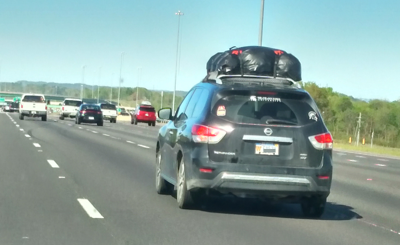Why Do You Need a Cargo Carrier?
 Some vehicles come with ample storage space, and you might be fine with just using your car’s trunk for your day-to-day needs. However, you may occasionally find that your vehicle doesn’t have enough cargo space to accomplish what you need. Some common reasons people opt to invest in carriers include:
Some vehicles come with ample storage space, and you might be fine with just using your car’s trunk for your day-to-day needs. However, you may occasionally find that your vehicle doesn’t have enough cargo space to accomplish what you need. Some common reasons people opt to invest in carriers include:
– Luggage space while traveling.
– A place to stow camping gear.
– Moving cross-country by car.
– A need to carry specialized gear, like emergency supplies or medical equipment.
It’s much easier and cheaper to buy extra cargo space for your vehicle than to upsize your car. You don’t have to buy an SUV just for storage space if you can find the right carrier for your family sedan.
Knowing why you need a carrier will help you to decide on the best style. Knowing how the carrier will be used will help you choose the right size, which may be a deciding factor in selecting a carrier.
Difference Between Car Top and Hitch Carriers
The most obvious difference between a car top carrier and a hitch cargo carrier is where on the vehicle the carrier will be installed.
A car top carrier, also called a roof rack, sits on the top of the car. Some vehicles already have the base set up for a luggage rack; others will need this base to be installed before a carrier can be used.
A hitch cargo carrier attaches to the tow hitch of the vehicle. This means that items will be stored at the vehicle’s rear rather than on its roof. Depending on your vehicle’s overall size and profile, this may be either a benefit or a drawback for this type of design.
Benefits and Drawbacks of Car Top Carriers
 Car top carriers provide many benefits. You can a roof rack to carry very large items that are longer than the roof itself, such as a kayak. Car top carriers designed for the roof come in a variety of sizes, with some being quite streamlined. For example, the Thule Sidekick has a low profile but still manages to hold 8 cubic feet of storage space.
Car top carriers provide many benefits. You can a roof rack to carry very large items that are longer than the roof itself, such as a kayak. Car top carriers designed for the roof come in a variety of sizes, with some being quite streamlined. For example, the Thule Sidekick has a low profile but still manages to hold 8 cubic feet of storage space.
A car top carrier can be installed on any vehicle, and cargo carriers can be removed when not in use. Many cars come with roof racks already, making it easy to install a car top carrier when necessary.
There are, however, a few drawbacks to roof-based car top carriers. If you usually park in a garage, your vehicle may not fit inside with the carrier on; some vehicles are so tall that simply adding the roof rack without the carrier box already makes the garage a tight fit.
Short-statured car owners may also struggle to reach cargo stored on the roof, and lifting the cargo box overhead can be a challenge.
Additionally, a car top carrier can change the vehicle’s profile; in cars that are already tall or boxy, this could affect wind resistance or fuel efficiency. Choosing a more aerodynamic design can help solve this issue.
Benefits and Drawbacks of Hitch Cargo Carriers
Hitch cargo carriers are held on racks connected to the vehicle’s tow hitch. This means that the box will be held at the vehicle’s rear rather than on the roof. This may affect the usable dimensions of the carrier since lower profile vehicles will not have as much space to accommodate a rear carrier.
Trailer hitch cargo containers are easy to access and can be loaded and unloaded without reaching overhead. This is an attractive feature for those who would struggle to reach an overhead container.
The biggest limitation to a hitch carrier is that not every vehicle comes with tow hitch capabilities. Additionally, weight limitations may make a hitch cargo container less practical; your car might be able to carry more weight on the roof.
Additionally, visibility concerns may be an issue. The container must be small enough to avoid blocking the view through the rear windshield. The extra length added to the car can also make maneuvering and parking more of a challenge.
Choosing the Right Cargo Carrier for Your Needs
When deciding on a cargo carrier, there are several factors to consider:
– The type of items you plan to carry or store.
– The amount of storage space you require.
– The size of your vehicle.
– Whether you would be able to reach a roof rack.
– Whether your car already has a roof rack or tow hitch installed.
– Whether it would be possible to install a roof rack or tow hitch.
– Weight and size considerations for your vehicle.
– Whether the cargo carrier might affect your car’s fuel economy.
– Whether you will use the rack for anything else, such as bike storage, or if it will use the cargo carrier exclusively.
If your vehicle already has a roof rack installed, it may be easier to buy a cargo container to fit it. If not, using the tow hitch may be simpler than installing the roof rack, which will become a permanent fixture of your vehicle. However, if your car currently has neither feature, it’s up to you to decide which option makes the most sense for your needs.
By assessing your needs, you will have a better idea of what to look for. Once you know what features you require, you can begin searching for a cargo carrier that will suit your needs. Be sure to read consumer reviews to ensure you invest in a high-quality carrier that will be useful for years to come. If you need help getting started, these cargo carrier reviews can help point you in the right direction.